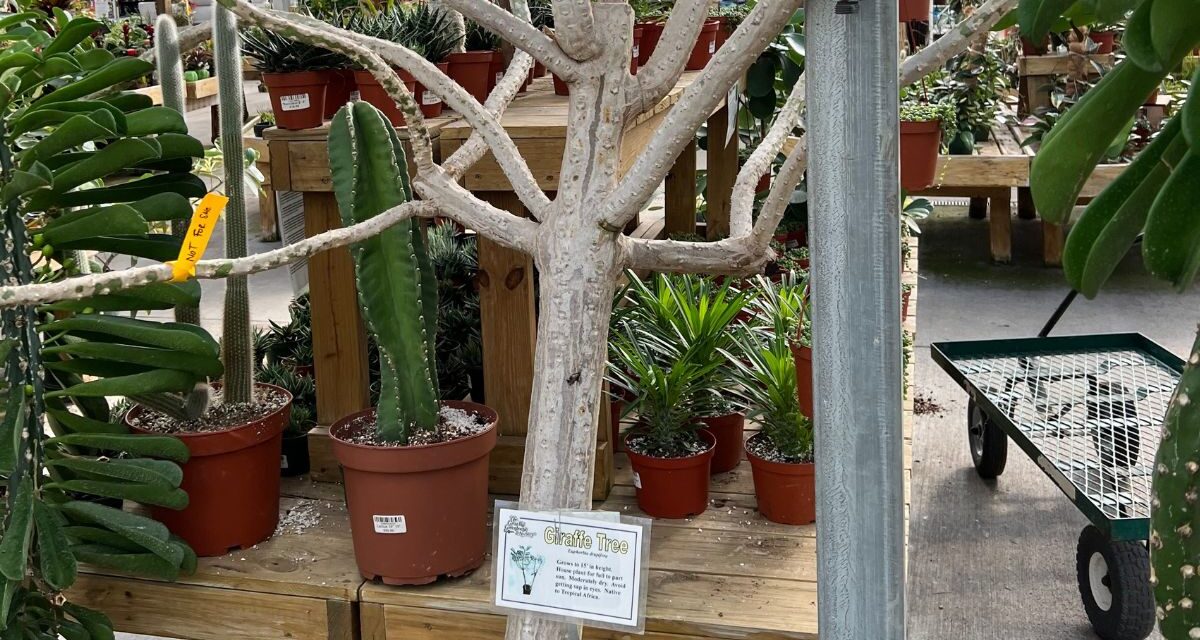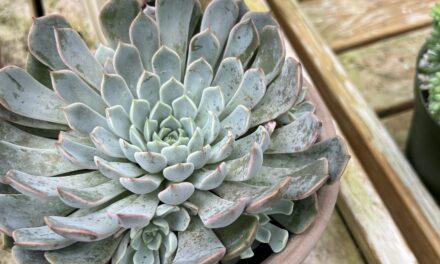If you’re a succulent fan, the unique world of tree succulents may fascinate you! Tree-like succulents are a unique type of plant that share characteristics with both trees and succulents. They have distinct tree-like “trunks” that can grow several meters high just like a tree. Plus, the uniquely beautiful leaves of these plants still retain their trademark water-storing capabilities. Additionally, succulent trees are known for being particularly hardy and easy to care for, especially in arid or desert environments. Whether kept indoors or outdoors, here are 15 succulent trees that will add a charming desert aesthetic to any growing space.
1. Elephant tree
The elephant tree, sometimes called the “elephant bush” or “elephant food plant” is a popular landscaping and indoor houseplant. It has deep reddish-brown stems and branches with ovate, fleshy, succulent leaves. In the Spring, it blooms with tiny purple star-shaped flowers. The elephant tree is drought-resistant and thrives in bright, sunny, dry conditions.
As the name suggests, these plants are a favorite food among elephants and other animals, like goats and tortoises, to name a few. Humans also enjoy the leaves and other parts of the tree, as it is a common ingredient in South African cuisine. These striking and large growing plants are incredibly low-maintenance, easy to shape, and can thrive indoors as a houseplant, or outdoors.
2. Jade Bonsai
The Jade bonsai succulent tree, also known as “Dwarf Jade” or “Jade Tree”, is one of the most popular choices of bonsai and Succulent trees— thanks to their unique appearance and low-maintenance care requirements. Similar to the Elephant Bush, these miniature tree-like succulents feature thick, juicy, water-storing leaves, making them drought-tolerant and suitable for warm and dry environments. It’s important to mention that although it shares some similarities with the Elephant tree, the Jade Bonsai leaves are not edible and may be toxic to pets and people if ingested. With proper pruning and shaping techniques, jade bonsai trees can be trained to grow up to 10 feet high or kept down to a more manageable size in your favorite indoor planter.
3. Australian Bottle Tree
The Australian bottle tree, also sometimes called Kurrajong, is a succulent ornamental tree known for its adaptability and ease of care. As the name suggests, Australian bottle tree succulents are native to Australia and are known for their large, bulbous, water-filled trunk that gives them a distinct “bottle” shape.
These huge trunks store water during times of drought which makes these giants incredibly drought-resistant and suitable for many growing environments. The Australian bottle tree is most often kept outdoors due to its size which can reach heights of 10 ft. or larger. The leaves of the Australian bottle tree are usually large and create a protective shady canopy, making it ideal for gardens in sunny climates.
4. Miniature Pine Tree Succulent
The Miniature Pine Succulent, sometimes called the Crassula Mini Pine, is a South African succulent. The mini pine succulent can reach heights of 3-5 feet, making it suitable for either indoor or outdoor succulent gardens.
These unique and beautiful plants feature densely packed rows of fleshy, succulent leaves that grow from woody tree-like branches to resemble pine needles. Attractive cream-colored flowers bloom in late Spring which adds an elegant touch to this popular tree succulent. As with most other succulents on this list, the Mini pine will do best in well-draining soil with infrequent watering and plenty of sunlight.
5. Desert Rose
The desert rose is a slow-growing flowering succulent plant that can grow anywhere from 3-10 feet tall! Its unique tree-like look – with thick water-filled trunks and branches – makes it a winning pick for succulent tree collectors. The Desert Rose is admired for producing spectacular rounded star-shaped flowers in striking shades of pink, red, and cream and is one of the most popular succulent trees among miniature and ornamental tree fans. Similar to other succulent plants, it needs plenty of sunlight and an infrequent watering schedule to thrive in both indoor and outdoor environments.
6. African Milk Tree
The African Milk Tree Succulent is a drought-loving tree-like succulent native to Africa. This decorative cactus-like succulent is known for its tall, pillar-like branches, and unique leaf structure. The African Milk Tree features long, 3-sided, elongated stems with thorny ridges surrounded by a crown of elliptical leaves.
When grown outdoors, it can reach impressive heights of up to six feet! However, it is also common to keep them indoors in planters. Wherever you choose to keep it, this fast-growing, drought-tolerant succulent is prized among gardeners for its quick growth, adaptability, and easy care requirements.
7. Hobbit Jade Bonsai
This succulent variety of the jade plant features thick, tube-like, fleshy leaves with curled edges and reddish tips. The Hobbit Jade succulent can grow up to three feet tall with larger plants bearing woody trunk-like stems. In Spring and Summer months, outdoor plants may bloom star-shaped pink and white flowers adding to the beauty of this unique succulent tree.
The Hobbit Jade is slow-growing but can reach impressive heights under ideal growing conditions. As with other succulents, this plant prefers to be kept in partial or full sun in well-draining soil. As a drought-tolerant plant, the Hobbit Jade Bonsai only needs to be watered when the soil is very dry.
8. African Baobab
As the largest succulent plant in the world, the African Baobab has a rich history full of superstition and mystery! The African Baobob tree is an important food and water source for people and animals in Africa, which is why it is sometimes referred to as the “Tree of Life”. This unique and massive succulent tree can grow to be around 80 feet tall and the trunk can grow just as wide!
Growing a Baobab tree succulent at home is usually accomplished by planting one from seed or cuttings. They require at least 6 hours of bright, direct sunlight per day and will thrive in warm, dry environments with sandy, well-draining soil.
9. Ponytail palm
The ponytail palm is native to Mexico and features a distinctive swollen trunk that is swollen at its base. Its elongated and thin leaves cascade like long locks of hair, giving rise to its name: the ponytail palm. Despite its name and palm-like appearance, the ponytail palm is a succulent and not a true “palm.”
With proper care and plenty of sunlight, this plant can grow up to 10 feet tall and is prized for its resilience and adaptability in various growing conditions. If you are looking for a unique and versatile plant that can be kept indoors or outdoors, the Ponytail palm may be a great succulent tree for your home.
10. Madagascar Palm
Similar to the ponytail palm, the Madagascar palm is a succulent plant rather than a true palm. This popular succulent tree plant photosynthesizes primarily through its enlarged trunk that can reach heights of up to 10-15 feet tall when grown outdoors. However, the
Madagascar palm is most popularly kept indoors as a houseplant where it can be kept to a more manageable size, especially in cooler climates.
In the Summer months, the Madagascar palm bursts with large, fragrant blooms of white, yellow, red, and pink flowers!
11. Joshua Tree
From the southwest region of the United States, the Joshua Tree is a popular slow-growing succulent that shares its lineage with the Yucca family. Famous for its ease of care and wild appearance, this succulent tree is frequently found peppered throughout xeriscape gardens, indoor and outdoor growing spaces, and even desert national parks.
However, these trees will usually only grow in their native habitat, where Summers are long, hot, and dry, with a dramatic shift in cool winter temperatures. So, if you live in the Southwest region of the United States or in a very arid and dry area with cool, mild winters, Joshua trees are likely to be available at your favorite garden store or nursery. These beautiful and bold succulents add a captivating and aesthetically pleasing focal point to any desert garden.
12. Pencil Cactus
The pencil cactus gets its name from its thin, elongated, water-filled branches that have the same general shape and size as pencils do. This sage-green succulent can grow up to 30 feet tall outdoors in its natural habitat, but when kept indoors it can easily be pruned to control its size and growth.
The green pencil-shaped stems contain a milky sap that can be mildly toxic to pets and humans. This sap gets released when crushed, cut, or chewed. Despite this, pencil cacti are unique, memorable, and attractive desert plants suitable for a variety of indoor and outdoor growing spaces.
This unique tree is drought-tolerant and does best when kept in bright sunlight, making them ideal for growing year-round in dry, warm climates or in brightly lit indoor grow areas.
13. Medusa Aloe tree
The Medusa aloe tree is a unique, tree-like succulent that can grow to heights of around 3 meters or more. This bold and striking succulent tree is famous for its long, flowing, vermicular green leaves that resemble the snake-like hair of Medusa, as described in Greek mythology.
In the Winter months, flowering stalks erupt from the center with large blooms of pendant-shaped flowers in shades of pink and orange – making it a gem to have in your yard or Winter garden. As with most succulents, this beauty requires very little water and plenty of sunlight. While the Medusa aloe tree does best when kept outdoors in well-draining sandy soil, it can be started inside or grown as a bonsai tree.



